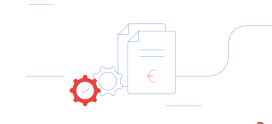22. February 2022
Happy paperless: How to make the leap to the digital office

Strategy without tactics is the slowest route to victory. Tactics without strategy is the noise before defeat. – Sun Tzu
Our working world is in a state of flux at the moment. In recent months, many companies have decided to map their processes predominantly digitally in order to be able to act in the home office as well. But of course it’s not that easy to convert all analogue processes into digital ones from one moment to the next. Even the best tactics are useless without clear strategies. But if the goals are clearly defined and the route cleverly chosen, the successful leap into the digital office can be made in just a few steps.
Why does a paperless office offer so many more benefits than its analogue counterpart?
The Corona pandemic has shown us how valuable it can be to be able to access all your documents anywhere – and even work on them together with others. Working in the cloud – with its transparent and accelerated processes and workflows – suggests that the time is over when invoices have to be laboriously transported from A to B before they can be posted. Not to mention the information or enquiries that first have to be found out via corners before the customer receives an answer. All this is precious time that is wasted. And time, as we all know, is money. Not to mention the newly gained motivation of the employees when they are allowed to free themselves from the annoying duties again in order to devote themselves to their core tasks.
But working fully digitally is much more than that. It also means being free and having the freedom to work in the place where the work can be done productively and efficiently. Be it in the favourite office, at the cosy dining room table – or in the converted van, exploring the world on the side. This privilege would be unthinkable with analogue processes. Yet it is obvious to work where we feel most comfortable – because that is where we are most productive. This is also confirmed by numerous studies, such as the IBA study from the year 2017.
What is the best way to realise a digital office?
Basically, there are two ways to a digital office. Either the paper-based processes and workflows are gradually transferred to digital or the entire office is digitised at once. Both variants have their advantages and disadvantages, with many companies opting for a gradual changeover for several reasons. „We always recommend to our clients that they take it easy when switching from analogue to digital and not digitise all their processes at once. After all, they have been working on paper for the last few years. You should be able to survive a few more weeks.“, advises Amagnos IT consultant Jan-Dirk Janssen with a smile. A gradual changeover also offers the possibility of keeping everyday office life running as smoothly as possible, which is almost impossible with the “jerky” approach. At the same time, a gradual migration enables those processes that seem most necessary to be transferred to digital first. In this way, the digitisation process can also first be sounded out and, if necessary, adapted for further processes.
In 5 steps to the digital office
- Once the path of how has been clarified, it is important to examine the existing processes and assess their paper volume. In most cases, it quickly becomes clear which processes should be digitised and with what priority. „The first process should ideally be the one that hurts the most.“, recommends Amagno’s digitalisation expert Nadine Hoting. „For many, this is the invoice receipt process or the digitisation of incoming mail.“
- In a second step, the paper-based processes are examined more closely and analysed to see how the processes have worked so far.. „This helps to identify their strengths and weaknesses and to gain valuable inspiration for the design of digital workflows.“, recommends Nadine Hoting. Jan-Dirk Janssen also interjects: „It is also highly recommended to outline the process together with colleagues from the specialist departments. For many companies, brainstorming together already gives them a first idea for building their digital workflows.“
- With a rough idea of a possible design, the journey for suitable tools can begin. Since many companies start with the digitalisation of their incoming mail or the digital mapping of their invoice workflow, we would like to give you an example impulse for a possible realisation:
The letters, receipts or documents are sent via cloud services such as Dropscan or Invoicefetcher received. Since most of the services are connected to the common ERP and ECM solutions such as Sage, Datev or Amagno offer, the documents are sent directly there. Due to the high demand, many providers already offer ready-made solutions (such as the digital invoice workflow) to make the start into the digital office even easier. These solutions also work hand-in-hand with others so that data and information can be transferred with just a few clicks.
- Once the right providers have been found to map the workflows, it is important to involve all employees in the tools and processes: „The higher the participation of the employees, the higher the acceptance of the companies for their project“, knows Amagno’s digitalisation consultant.
- Finally, the leap into the digital world follows. There are numerous options for transferring analogue processes into the digital world. Many decide to scan their documents or to use the support of a scanning service provider, e.g. a digital imaging company. Servlog, migrate the files relevant for storage to digital. „To ensure that everyone involved feels comfortable working with their new tool right from the start, it is worthwhile to adapt the naming of task steps (as is the case with an ECM solution, for example) to the company’s internal “slang”. Also, value should be placed on a clean structure.“, advices Jan-Dirk Janssen.
Despite all the euphoria of a digital solution, the destruction of analogue documents should be well-considered. This is because many documents are subject to retention and archiving obligations that must be observed. The same applies to the data protection-compliant destruction of documents that are no longer needed. „AProcedural documentation, which describes where the documents are located, who may import them and who may destroy them, makes it possible to destroy the documents in paper form before the retention period expires. In order for this to succeed, trained tax advisors or auditors assist with the creation of“, says Nadine Hoting.
Enjoying digital freedom
If all processes have been digitised, automated and adapted to the digital workflow, this not only enables more productive work and the sharing of information with other systems. The flexibility of a digital office to work at any time and any place sets the course for a successful entrepreneurial future.



